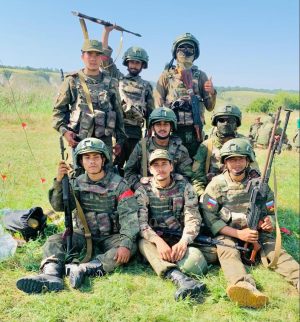On December 13, 2023, a group of seven Indian men gathered at a restaurant in the southeastern city of Chennai. Strangers to one another, the men drank chai and shared biryani, bonding over stories of their home provinces, from the Himalayan valleys of Kashmir to the coastal plains of Kerala.
Just days earlier, the men had flown to Chennai from across the country. Instructed to pack lightly, some carried little more than a few changes of clothes along with shiny new passports, freshly stamped with Russian tourist visas. They were told to wait in Chennai for further information.
Over the coming days, the men became inseparable. “We ate breakfast, lunch, and dinner together,” explained Mohammed Sarfaraz, who was part of the group. The 28-year-old restaurant worker had traveled from his native Kolkata. “We were all very nervous,” he said.
Joining Sarfaraz was Azad Yusuf Kumar, a 31-year-old engineering graduate from Kashmir, and Syed Ilyas Hussaini and Mohammed Samir Ahmed, two 24-year-olds from Karnataka who both left catering jobs at Dubai airport to move to Russia. Also among the men was 27-year-old Surinder Paul from Jammu, Parveen Lamar from Darjeeling, and Mohammed Tahir, a 24-year-old from Gujarat.
As agents picked over the final details of their departure, the group were introduced to other men who would also be making the same journey: Hemil Mangukiya, a 23-year-old embroiderer from Gujarat, and Mohammed Sufiyan, a 24-year-old from Telangana.
The men exchanged numbers and made promises to one another. “Since we were going together, and had spent time together, we said that when we go, we will stick together,” Sarfaraz explained in Hindi during hours of voice calls.
But soon after, the men were divided into smaller groups and given different departure dates. Over the course of eight days the men all left for Moscow. First, Mangukiya and Sufiyan left with another group of men. Next, Kumar, Hussaini, Samir Ahmed, and Surinder Paul flew via Bahrain to the Russian capital. And on December 22, Sarfaraz, Tahir and Lamar made the journey.
*****
Despite their clashing languages and customs, the men had all been lured to Russia by similar promises; well-paid work abroad and the possibility of securing foreign citizenship. The offer was attractive in India, where an acute labor crisis had left over half the working age population out of official employment.
Until June 2023, Sarfaraz worked seven days a week in the kitchens of a luxury five-star hotel in Kolkata, serving food to international business people passing through the city. The days were long and stressful, he said, and at just 18,000 rupees (around $200) a month, the wage was barely enough to support himself and his father, who required costly gangrene treatment.
Sarfaraz’s problems only mounted when a change in management at the hotel cost him his job. Before long, he found himself scouring the internet in search of work. In September, he came across the page of a YouTuber named “Baba Vlogs,” run by an Indian man based in Dubai named Faisal Khan. On his channel, Khan was offering well-paid work across the globe for even low-skilled Indians.
In one now deleted video, Khan advertised a “security helper role”’ in the Russian Army. In the video, Khan boasts men could earn up to 200,000 rubles a month working in logistics way behind the frontlines. “The [Russian] government feels that all those helping in these times need to be given benefits. This [job] will give you permanent residency,” said Khan as he wandered the streets of St. Petersburg in a separate video uploaded in September.
“Within five minutes, I contacted him,” Sarfaraz recalled. Two months later, he had emptied out his savings to pay for a visa and cover letter and scrape together just some of the 100,000-rupee commission Khan requested on top. “The rest he said I could pay in installments once I received my first pay check,” he said.
*****
Late at night on December 22, Sarfaraz, Tahir, and Lamar were quietly led into Chennai airport by two close confidantes of Khan. The men, one a goateed man called Michael and the other who went unnamed, handed them their flight tickets and insurance, and gave them strict instructions to say they were traveling for tourism purposes only.
The men were assured that once they got to Russia, their visas would be changed to work visas, but Khan and his team had been coy about the details of this, the men told The Diplomat.
“We didn’t know anything. I was just happy that I was going to Russia,” said Mohammed Tahir in a phone interview from his native Gujarat in January 2024. “When we passed through immigration and headed toward the flight, I was excited. It was my first time traveling on a plane.”
Having only recently turned 24, Tahir was one of the younger men that traveled from Chennai to Moscow in December. A carpenter from Ahmedabad, Tahir recalled that when he first told his parents he would be closing his carpentry shop and going to work for the Russian Army, they begged him not to leave. “But after I mentioned it was good money and we would be financially stable, they were convinced,” he said.
In comparison to the other groups before them who had experienced issues at immigration both in Chennai and in Moscow, Sarfaraz, Tahir, and Lamar breezed through. As they nervously edged closer to the front of the queue at Moscow’s Domodedovo airport after a days-long journey, they recited the instructions they had been given by Khan’s men.
“We said that we were tourists and had come to visit Russia for the Christmas period,” Tahir said. Sarfaraz was surprised to find that the border officer already had some of their details. “They asked us to sign some documents, and then said ‘welcome to Russia,’” he said.
*****
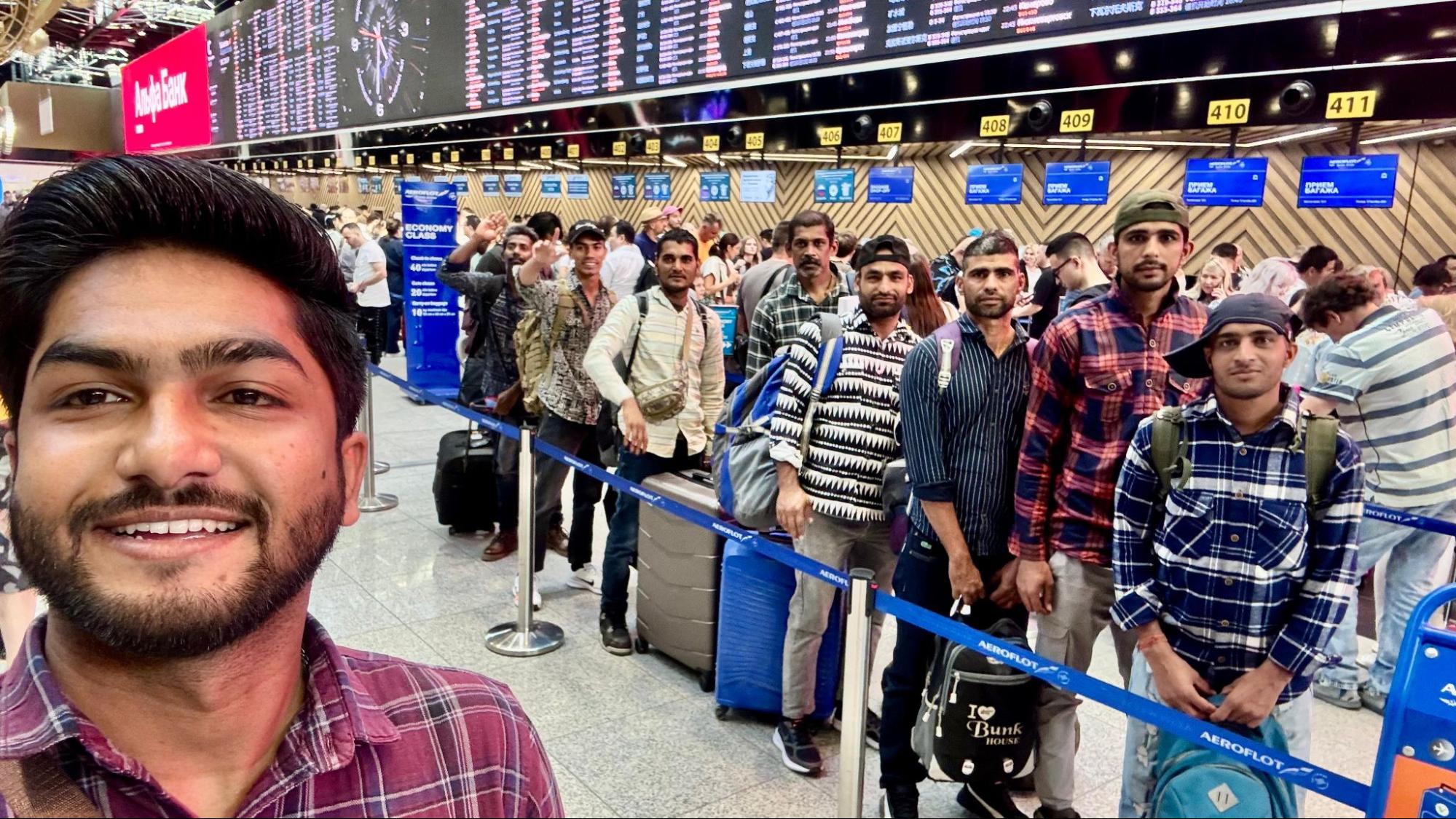
Raja Pathan and his group wait at a Moscow airport. Photo courtesy of Raja Pathan.
By the winter of 2023, Ukraine’s long-awaited counteroffensive to take back lost territory in the country’s south and east was stalling. Russian forces, anticipating the offensive, thwarted Kyiv’s efforts by establishing dense layers of fortifications along the front, digging intricate networks of trenches, tunnels, and anti-tank bunkers, and laying down thousands of land mines.
In the rear of those defensive lines was Raja Pathan, a 26-year-old Indian from the northern Indian city of Chandigarh, a modern city that serves as the regional capital to both Haryana and the neighboring state of Punjab.
Unlike the other groups of Indian men that began arriving to Russia in late 2023, Pathan had come to Moscow almost a year earlier, on January 2, 2023, to study e-commerce at a Moscow University, he said in a phone interview. Pathan said he traveled to Moscow on a student visa arranged by an agent, and hoped to use his future degree to facilitate business between India and Russia.
But weeks after arriving in Russia, Pathan learned the agent had tricked him and there was no university place. Within months, he signed a contract with the Russian Army, claiming to have been enticed by the military advertisement posters that are ubiquitous along Moscow’s streets. “I had to do a general exam on what I thought about Russia and the president, and I passed,” Pathan said.
After signing the contract, Pathan, along with his friend Abishek, became the first Indian nationals serving in the Russian Army. The pair were shown a map that marked the four different areas of the conflict, ranked in order of danger, from the frontline to red, amber, and green zones behind it. At first they would be working as helpers in the amber and green zones while undergoing training, Pathan said.
Along with six other men from Nepal, the men trained at a military base in the city of Klintsky in the Russian region of Bryansk, just 80 kilometers from the Ukrainian border. The group learned how to shoot a rifle, detonate grenades, and dig trenches, Pathan said.
From there, they were sent to Kreminna, a Russian-occupied city in Ukraine’s Luhansk region that has seen some of the most brutal fighting in the three-year-war and serves as a key footing in Russia’s defensive line southwards through the Donbas region.
There the group was given orders to carry out a special mission on the frontlines, Pathan said. “We were told we were the first international Storm group and that we were being sent to do face-to-face fighting,” he added.
Reports and Western intelligence in April 2023 first noted that to stifle Ukraine’s counterinsurgency, Russia had begun forming special assault units known as “Storm-Z” groups. The battalions, although reportedly under the command of the Defense Ministry, are primarily made up of prisoners and are sent to some of the most perilous areas of the frontline, a tactic harking back to the “punishment battalions” deployed by Josef Stalin during World War II.
“A lot of men began arriving from jail,” Pathan said. “They were making bunkers, each bunker had 25 to 30 people living in it,” he added. “One guy showed me videos of his group, he said there were 117 people who took part in an assault and only 15 were alive [afterward]. After that, I was scared,” Pathan said.
In Kreminna, Pathan described the conditions as very difficult. Food and water were often scarce, while drones buzzed overhead and artillery reverberated through the charred pine forests.
Following orders to carry out the assault, Pathan and Abishek pleaded with their commander to be discharged. But the Nepali guys, “they made a mistake,” Pathan said. Most came from very difficult financial circumstances in Nepal, and were incentivized by the additional bounties offered to Storm members for capturing land or destroying enemy assets, he said.
In September, Pathan and Abishek returned to their barracks in Bryansk, while the six Nepali men left on the mission. Within days, Pathan received a call from one of the men explaining that he and three others in the group had been injured in the assault. The other two men, Yadav and Ramesh, were dead.
*****
At Moscow’s bustling Domodedovo airport, Sarfaraz, Tahir, and Lamar were met by an Indian man named Nigel, an associate of Khan who had spent days shuttling between the airport and Moscow city center, meeting the new arrivals.
Nigel showed the three men to his spacious, three-bedroom apartment in the city, which acted as a makeshift sorting center for migrants arriving to Russia, Sarfaraz said. In the apartment, the men also met Nepalis as well as Sri Lankans.
After three days, the men were driven to the city of Kostroma, a city on the Volga River 400 kilometers northeast of Moscow, where they arrived at a military enlistment center. At the office, the men were presented with a four-page document written entirely in Russian.
Despite the presence of a military officer who spoke some English, each of the men who spoke to me said that they were unaware of most of the details in the document, but were told by Khan they should sign it if they wanted to receive a work permit.
From there, the men were transferred to a military training base in Ryazan, a proud military city 200 kilometers southwest of Moscow that boasts of being the home of Russia’s elite paratroopers. On arrival, the men’s phones and passports were confiscated, and they were given army uniforms and thick-soled leather boots, which they were instructed to wear at all times.
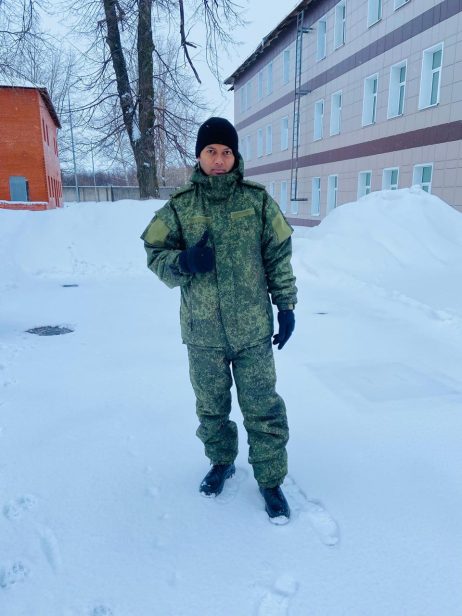
Mohammed Sarfaraz poses in army uniform at camp. Photo courtesy of Mohammed Sarfaraz.
A photo of Sarfaraz in late December shows him standing in shallow snow in front of an army barracks wearing camouflage uniform and black gloves, giving a nervous thumbs up to the camera. “We were immediately treated like army members,” Sarfaraz said. “We had to wake up very early and salute other army people.”
At camp, the men snacked on bread and jam, and were given innocuous tasks such as cleaning the toilets and clearing the unrelenting winter snow that gathered on the tarmac of the military base.
Yet the place bore constant reminders that war was never far away. Each day, huge green military trucks, shaped like shoe boxes, would pass through the gates of the compound. Soldiers frantically spilled out onto the turf, sharing shocking stories and carrying even more harrowing injuries. “People arrived with no fingers, no arms, in one case no ankle. One man had a head wound that looked like he’d been shot by a sniper,” Sarfaraz said.
It wasn’t until a conversation with one recently returned servicemen that the Indian men realized what they had signed up for. In broken English, the soldier approached the men and thanked the group for supporting Russia.
“We explained we weren’t there to support Russia, but just to do jobs [in the camp]. He answered that there were no jobs, other than fighting in the army,” Sarfaraz recalled.
Their panic reached fever pitch several days later, when Tahir received a voice message on a phone he had smuggled into the base. It was from Sameer Ahmed and Hemil Mangukiya, the men they had met in Chennai.
The two men warned that they had been tricked and were now in Ukraine. They explained that they could not communicate much due to the threat of drones, but that the men should escape while they still could.
*****
Over the next week, the three men frantically pleaded with agents and embassy staff to be relieved of their duties. Both parties said they were trying to help but did nothing, Tahir and Sarfaraz said.
Meanwhile, when they explained to their commanders there had been a mistake, the officers continually reassured them that there was nothing to worry about. “They knew we were going to die in Ukraine, so they did not tell us openly what was happening there,” Tahir recalled.
In the late afternoon of January 17, an officer approached the men and told them that the following day they were being deployed to the border. None of the men had undertaken even a day’s training, they said. That evening, Sarfaraz plotted his escape.
“I knew I had to run away, but nobody wanted to come with me. So I decided that alone, I was going to run,” he said.
Late in the evening, Sarfaraz packed a small bag of clothes, and quietly wheeled a dustbin up against the 12-foot-wall. As he threw a towel over the spiraling razor-wire, he was spotted by the camp’s guard dogs.
“I am an animal lover and had been feeding the dogs everyday in the camp so they didn’t bark,” Sarfaraz said. “I climbed the barbed wire. It was very foggy and the snow was thick. There were some railway tracks. Before leaving I checked the direction, and for around 5 kilometers, I just walked.”
After trudging two hours through the forest, Sarfaraz arrived at a road that led to a familiar shop often frequented by the men at the camp. It was around 10 p.m. when he arrived. He remembers going inside, buying a cold drink and booking a 200 kilometer taxi north to Moscow.
*****
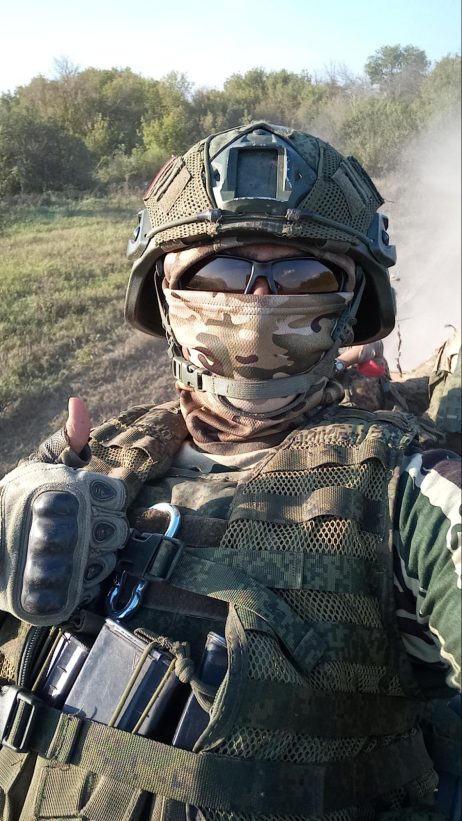
Raja Pathan gives a thumbs up in Russian-occupied Ukraine. Photo courtesy of Raja Pathan.
In May 2023, Russian President Vladimir Putin announced that foreigners who served in the Russian military in Ukraine would be fast-tracked for full citizenship. The decree also extends to family members of servicemen.
A way for Moscow to replenish its ranks after suffering staggering losses throughout the war, the president’s announcement led to a flurry of arrivals of men to Russia – mostly from poor but what the Kremlin considers “friendly” countries, such as Cuba, Afghanistan, India, and Nepal.
After being discharged from his unit in October 2023, Pathan returned to Moscow where he began navigating the new citizenship system. But amid the lengthy bureaucracy, Pathan, whose manicured looks and fluent English set him apart from the other Indians who arrived in Russia, found himself increasingly distracted by an unlikely sidetask.
Pathan’s phone began buzzing almost weekly with tens of calls from Indians claiming to be trapped in Ukraine. Most found Pathan through his popular YouTube channel, where in videos he had begun warning against taking jobs in the Russian Army and the dangers of underhand agents like Khan.
From his Moscow apartment, Pathan began compiling lists of people he had spoken to, relaying information between the frontlines and the embassy. He spent hours fielding calls with despondent family members back in India, reassuring them he’d raise their loved one’s case with officials. From his research, he was able to detail the names of over 100 men that arrived in Russia on similar pretenses.
According to documents seen by The Diplomat, 79 Indians signed contracts with the Russian army between December 2023 and September 2024. The real figure however, is likely closer to 150, with at least 20 Indians still serving on the frontlines, Pathan said.
Of those men, around 80 have since been discharged and returned to India, documents show. But not all have been so lucky.
On February 21, 2024, a Ukrainian drone struck a Russian position in the occupied-Donetsk region, reportedly killing a number of Russian servicemen. Also killed was the first Indian to die in the war: 23-year-old Hemil Mangukiya.
Tahir recalls speaking to Mangukiya just a week earlier, where he explained helplessly that he was trapped close to the frontlines. “We are both from Gujarat, so we had a good bond. He was a nice guy, smart and perceptive. The last time we talked he said don’t talk to anyone, just run and return to India,” Tahir said.
Less than two weeks later, the war claimed another Indian life. Mohammed Afsan, a 30-year-old graduate from Hyderabad, arrived in Russia on November 12 with the help of Khan, according to Afsan’s brother Imran. Four months later, on March 6, Afsan was declared dead by the Indian embassy in Moscow.
“I tried warning him not to come, but he chose to listen to the agent,” Pathan said, who had spoken to Afsan in November.
A video seen by The Diplomat shows Afsan shortly before his death holed up in a building in an unknown location with three other members of his unit, including his commander, who introduces himself by his name and patronymic, Sergei Evgenievich.
Staring into the camera, the quaking Afsan explains he has two bullets in his leg and one in his arm and is unable to walk. “Keep me in your prayers, I’m coming back soon in any condition,” he says. Afsan is reported to have died from his bullet wounds.
Also among the confirmed dead is 29-year-old Tejpal Singh, who was killed in March in a missile strike in the southern Ukrainian region of Zaporizhia. And in August, 36-year-old Sandeep Chandran from the Thrissur district in Kerala was killed in a drone strike in Donetsk. In addition, the youngest Indian reported to have died in Ukraine, 21-year old Ravi Moun, lost touch with his family in March but was only declared dead in July.
“Almost three months after speaking to Ravi, I got in touch with another Indian from his group. He told me that Ravi was in a tank when a missile dropped on it. All the people who were in the tank died at that moment. There was a huge explosion,” Ravi’s brother Ajay explained to The Diplomat from his native Haryana.
*****
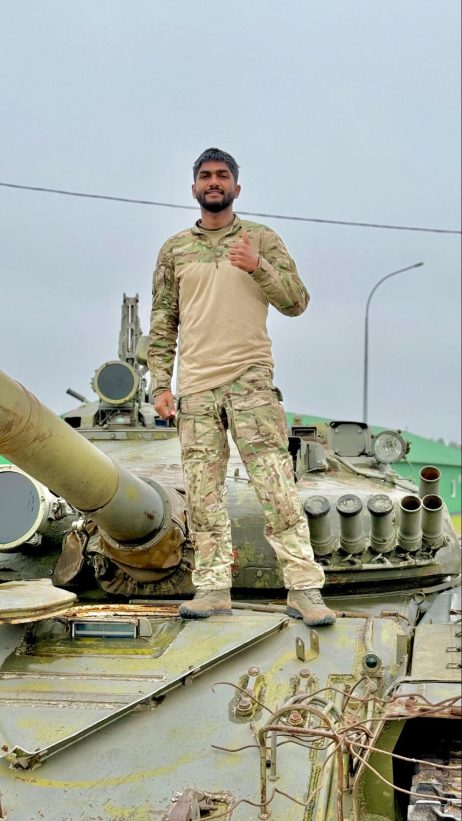
Raja Pathan poses on top of tank. Photo courtesy of Raja Pathan.
A total of 12 Indians have died in Ukraine, according to official figures released by the Indian External Affairs Ministry last month. The ministry also said 18 Indian men remain on the frontlines, 16 of whom are currently missing.
On January 14, a man named Babu Binil, also from Kerala’s Thrissur district, became the latest Indian to perish in Ukraine.
The mounting number of Indians fighting, and dying, for Russia has become a diplomatic sticking point between the two countries, whose relations during the Ukraine war have largely blossomed due to a deal that has seen Delhi enjoy favorable Russian energy prices in return for its ambivalence to Moscow’s invasion.
In a meeting with Putin at the Kremlin in July last year, Indian Prime Minister Narendra Modi asked for the release of those that had been “misled,” a call he reiterated when the two leaders met at the BRICS summit in Kazan in October 2024.
India’s External Affairs Ministry later said the Kremlin had “accepted” Modi’s request, and it would release Indians in its army, as well as offer compensation to bereaved family members.
When Hemil’s father, Ashwin Mangukiya, traveled to Moscow to arrange the return of his son’s body in March, he was informed that he was entitled to 10.3 million rupees, or roughly $120,000, as well as Russian citizenship.
Others though, have been left with no money and no corpse to bury. When The Diplomat spoke to Ajay Moun in December, he described desperately calling the embassy daily to seek Ravi’s return. “They keep saying that the Russian Army has not responded to them,” Ajay said.
“They asked my father to send DNA to see if it was matching, but we haven’t heard anything since then,” he continued. “Ravi’s body is just there in Russia, all on his own like an orphan,” said Ajay, a taxi driver who until his brother’s death, lived with Ravi on a small plot of land in their village of Mator in Haryana.
Neither the Indian Ministry of External Affairs nor Indian embassy officials in Moscow responded to requests for comments for this article. But Ajith Kolassery, the CEO of Norka Roots, a body that operates under the Kerala regional administration and has been assisting with the repatriation of Keralites, confirmed that the Russian Defense Ministry and Ministry of Foreign Affairs were cooperating with their efforts to bring men home.
*****
Sarfaraz didn’t arrive in Moscow until 2:30 in the morning. Still dressed in army attire and without documentation, he took shelter in one of the capital’s many 24-hour-cafes.
At 7 a.m., as the rising sun cast Moscow into a yellow haze, Sarfaraz marched to the Indian embassy. He yelled at passing staff members helplessly, explaining he had escaped the army and pleaded with them to help him return to India. But his cries fell on deaf ears.
One staff member paced outside, handed him a pen and paper and instructed him to write down all his problems and then return to the camp. “I started crying in front of him. He asked why I was crying and I said I didn’t want to go back. He said it’s an army issue, and that they can’t intervene with issues related to the army,” Sarfaraz said.
Trapped in Moscow, Sarfaraz weighed up his thinning options. In a cafe, a Punjabi man had shown Sarfaraz the channel of a YouTuber named “Laddi Belgium.” In the only video on Belgium’s channel, he describes how he smuggled himself through the forests from Moscow to Poland via Belarus before settling in Belgium – a practice known as “dunki” travel. Laddi Belgium also offers assistance to any of his followers looking to follow in his footsteps.
The number of migrants attempting to cross into Poland from Belarus has dwindled since a border crisis in 2021 in which Belarusian President Alexander Lukashenko flooded the Belarus-Polish border in attempts to destabilize Minsk’s Western neighbor. Still, the route remains a well-trodden path for refugees attempting to reach Europe, said Lydia Gall, a senior researcher on Eastern Europe at Human Rights Watch.
Having received his first pay check from the Russian army just days earlier, Sarfaraz called Belgium. The smuggler demanded 50,000 rubles (around $550) up front, and arranged for Sarfaraz to be picked up and taken to a flat in Moscow.
Sarfaraz does not recall where in Moscow the flat was, but recounts its dark aesthetic and acrid smell. For the next two weeks, he slept on the wooden floor of the one-bedroom flat, which he shared with a dozen other Indians, mostly from Punjab and Haryana, who were all hoping to make it to Europe. Agents would arrive to bring food, often just bread and butter, sometimes if they were lucky, a banana.
Early in the morning on February 3, a car arrived to take Sarfaraz and three others onwards to Minsk. The drive from Moscow to the Belarusian capital takes around 8 hours, and stretches along a two-lane highway that runs right the way to the Polish border. Approaching Belarus from the Russian side, police checkpoints become more frequent.
The driver managed to successfully evade the first three checkpoints. But at the fourth, they were stopped. A traffic officer barked at the group, demanding to see their passports. “I was the only one without a passport. When he learned I had no passport, he told me we were all going to jail for 6 months,” Sarfaraz recalled.
Eventually, the cop cut them a deal. He demanded 500 euros: 100 euros from each passenger, and an extra 100 from Sarfaraz for having no passport. After being paid, the officer waved them on.
Shortly after arriving in Minsk, Sarfaraz’s money ran out. He had paid Belgium a total of 200,000 rupees, roughly $1,800, and was forced to spend his days begging on the streets. “I wouldn’t even ask for money, just for food,” he said.
At night, he returned to a small three-bedroom apartment that housed 22 people. Most were Indians, but there were also some Afghans and Pakistanis. Old people, young people, families. Most had sold everything but the clothes on their backs to make the perilous journey to Poland.
In May last year, attempted crossings at the Poland-Belarus border peaked since 2021, with 7,090 attempted crossings in May, according to figures kept by the Polish border services. Refugees are treated with “heartlessness at every stage” on the journey to Poland, said activist Zosia Kransowolska, who runs the Polish organization Hope&Humanity that assists refugees in Belarus from outside the country.
During three weeks living between different squats in Minsk, Sarfaraz recalled the regular beatings and extortion migrants faced at the hands of agents. Most were so hungry they snacked on the contents of discarded tea bags and water. Women, some of whom traveled with their partners, were sexually exploited. On one occasion, when Sarfaraz was shown to a new flat, the agent swung open the door to find a man hanging dead from the ceiling. “I lowered him down, his neck was completely blue,” Sarfaraz recalled.
In this shadowy underworld, not even a specter of humanity remained, Sarfaraz said. “Nobody was helpful; everyone would just say: Don’t look back, just keep walking forward.”
*****
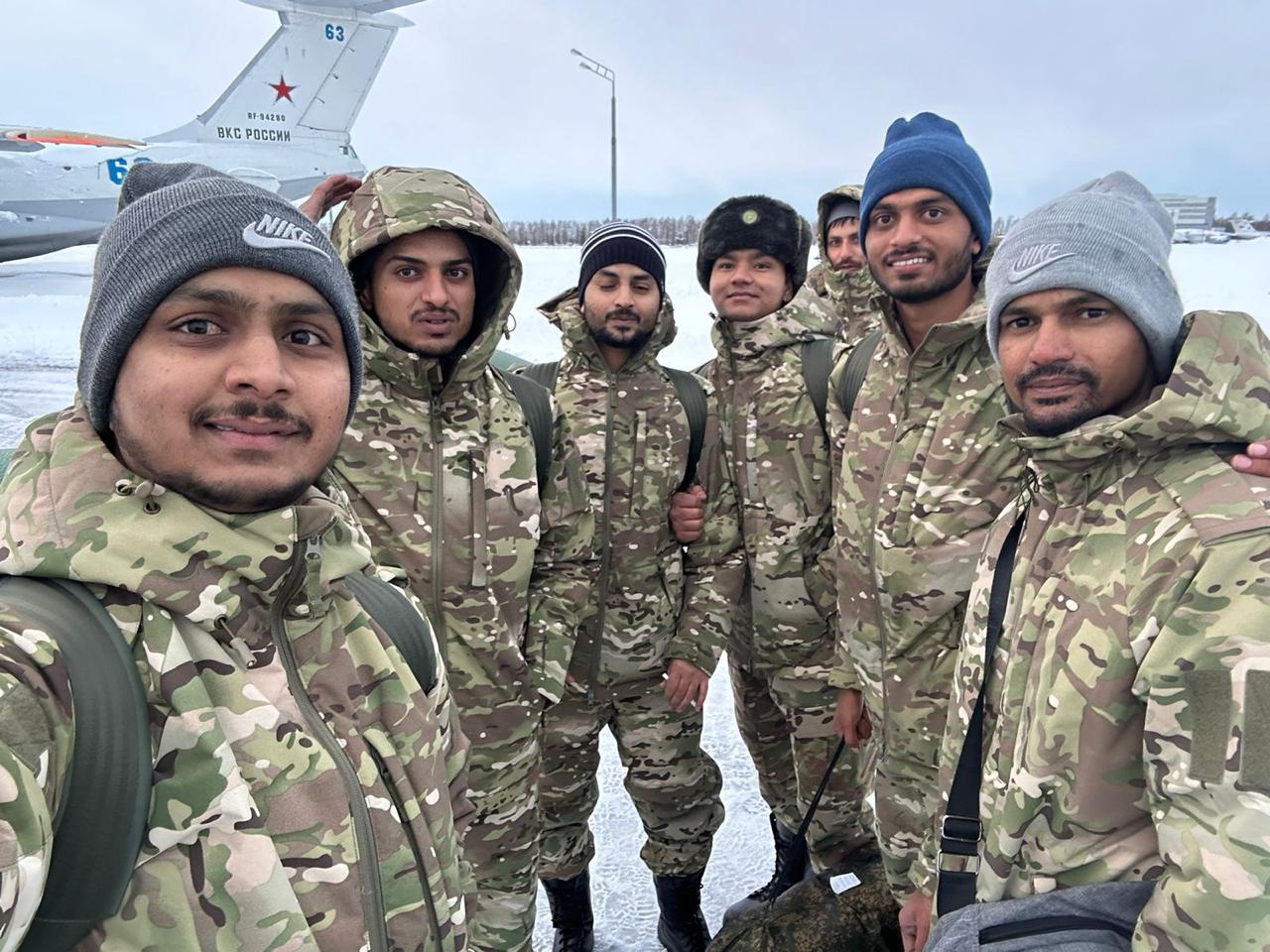
Some of the group from Chennai at a Russian airbase, including: Sameer Ahmed (left), Mohammed Sufiyan (second from left), Syed Ilyas Hussaini (middle) and Hemil Mangukiya (second from right). Courtesy photo.
In autumn last year, as the deep mud in Ukraine’s east began to freeze back into solid earth for the third time in the renewed war’s history, many Indians began to quietly return home.
Some whom I contacted for this article said they had been told not to share their story with journalists. Others asked for money to speak, citing the debt that they had accrued in their efforts to escape Russia.
In September, Syed Ilyas Hussaini and Mohammed Samir Ahmed returned to Karnataka; meanwhile, Mohammed Sufiyan arrived back to his central state of Telangana. That same month, Azad Yusuf Kumar arrived back to his village of Pulwama in Kashmir where he described feeling lucky to be alive.
“I returned with the help of the Indian embassy, Raja Pathan, and the Indian PM,” Kumar told The Diplomat in January.
Nine months earlier, on January 26, 2024, Tahir also returned to India after managing to escape from his ranks. When The Diplomat spoke to him, he detailed how he remains unemployed and heavily in debt since returning home. “I have to pay a lot of people money with interest,” he said.
When Sarfaraz last contacted Lamar and Paul in December, the pair remained in earshot of pounding artillery, but said they were planning their return to India.
Last year, on February 24, exactly two years to the day since Russian forces rolled over the Ukrainian border, Sarfaraz boarded a plane to India after securing a temporary passport from the Indian embassy in Minsk.
When the wheels touched down in Kolkata, Sarfaraz remembers an overwhelming sense of emotion. He pulled out his phone and immediately called his mother.
“She was crying when I came back. She kept thanking god. I was crying a lot also.”













